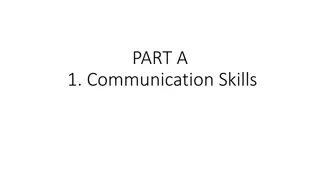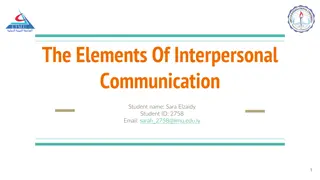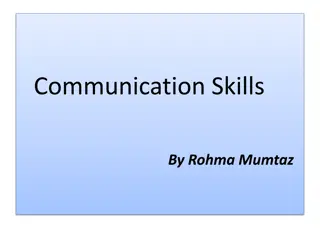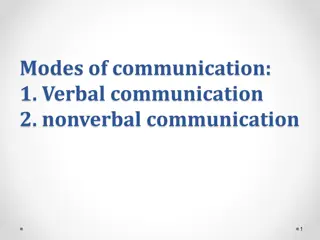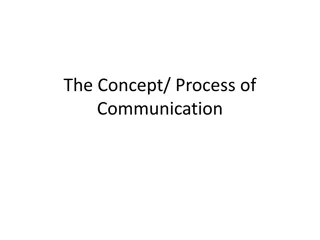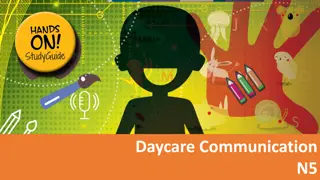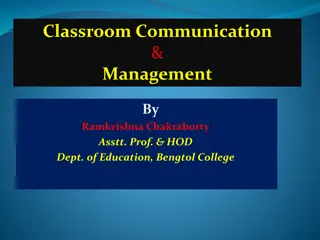Importance of Non-verbal Communication in Building Relationships
Non-verbal communication plays a vital role in connecting with others, expressing true intentions, and fostering better relationships. Understanding its significance can enhance trust and clarity while reducing tension and confusion in communication interactions.
Uploaded on Feb 21, 2025 | 1 Views
Download Presentation

Please find below an Image/Link to download the presentation.
The content on the website is provided AS IS for your information and personal use only. It may not be sold, licensed, or shared on other websites without obtaining consent from the author.If you encounter any issues during the download, it is possible that the publisher has removed the file from their server.
You are allowed to download the files provided on this website for personal or commercial use, subject to the condition that they are used lawfully. All files are the property of their respective owners.
The content on the website is provided AS IS for your information and personal use only. It may not be sold, licensed, or shared on other websites without obtaining consent from the author.
E N D
Presentation Transcript
Lecturer: Dr. Perpetua S. Dadzie, Dept. of Information Studies Contact Information: psdadzie@ug.edu.gh College of Education School of Continuing and Distance Education 2014/2015 2016/2017
Session Overview At the end of the session, the student will be able to: Understand the importance of Non-verbal communication Understand the Levels of Communication Identify the Barriers to communication Identify how to break the barriers Explain the Tools of effective communication Slide 2 Dr. Perpetua Dadzie, Dept of Information Studies
Session Outline The key topics to be covered in the session are as follows: Topic One - Non-verbal Communication Topic Two Levels of Communication Topic Three Barriers to Communication Topic Four Overcoming the Barriers to Communication Topic Five Tools of Effective Communication Slide 3 Dr. Perpetua Dadzie, Dept of Information Studies
Reading List Nonverbal Communication http://www.helpguide.org/articles/relationships/nonverbal- communication.htm Types and Levels of Communication http://www.ehow.com/info_8064650_types-levels- communication.html#ixzz2Hrz420dK Barriers to effective human communication https://en.wikipedia.org/wiki/Communication Slide 4 Dr. Perpetua Dadzie, Dept of Information Studies
Topic One NON-VERBAL COMMUNICATION Slide 5 Dr. Perpetua Dadzie, Dept of Information Studies
Definition and Importance of Non- verbal communication Good communication is foundation of any successful relationship. important to recognize that nonverbal communication facial expressions, gestures, eye contact, posture, and tone of voice speak loudest. nonverbal communication, or body language, powerful tool that can help connect with others, express what you really mean and build better relationships. Slide 6 Dr. Perpetua Dadzie, Dept of Information Studies
Definition and Importance of Non- verbal communication (2) Non- verbal is communication without words The way you listen, look, move, and react shows whether or not you care, being truthful, or listening. When nonverbal signals match up with words being said, they increase trust, clarity, and rapport. When they don t, they generate tension, mistrust, and confusion. Slide 7 Dr. Perpetua Dadzie, Dept of Information Studies
Definition and Importance of Non- verbal communication (3) to become better communicator, important to become more sensitive not only to body language and nonverbal cues of others, but also to your own. Five roles of Non-verbal Repetition: repeat message person is making verbally. Contradiction: contradict message individual trying to convey. Slide 8 Dr. Perpetua Dadzie, Dept of Information Studies
Definition and Importance of Non- verbal communication (4) Five roles of Non-verbal . Substitution: can substitute for a verbal message. For example, a person's eyes can often convey a far more vivid message than words do. Complementing: may add to or complement verbal message. A boss who pats a person on the back in addition to giving praise can increase impact of the message. Accenting: may accent or underline verbal message. Pounding table, for example, can underline message. Slide 9 Dr. Perpetua Dadzie, Dept of Information Studies
Types of Non-verbal communication Facial expressions human face extremely expressive, able to express countless emotions without saying word. Facial expressions universal. - facial expressions for happiness, sadness, anger, surprise, fear, and disgust are same across cultures. Body movements and posture posture, bearing, stance, and subtle movements. The way you move and carry yourself communicates wealth of information to the world. Slide 10 Dr. Perpetua Dadzie, Dept of Information Studies
Types of Non-verbal communication (2) Gestures We wave, point, beckon, and use our hands when we are arguing or speaking expressing ourselves with gestures often without thinking. Meaning of gestures very different across cultures and regions, so be careful to avoid misinterpretation. Eye contact The way you look at someone can communicate many things, including interest, affection, hostility, or attraction. Eye contact important in maintaining flow of conversation and for gauging other person s response. Slide 11 Dr. Perpetua Dadzie, Dept of Information Studies
Types of Non-verbal communication (3) Touch What message given by a weak handshake, a timid tap on the shoulder, a warm bear hug, a reassuring slap on the back, a patronizing pat on the head, or a controlling grip on your arm. Space You can use physical space to communicate many different nonverbal messages, including signals of intimacy and affection, aggression or dominance. Slide 12 Dr. Perpetua Dadzie, Dept of Information Studies
Types of Non-verbal communication (4) Voice It is not just what you say, it is howyou say it. When we speak, other people read our voices in addition to listening to our words. Things they pay attention to include your timing and pace, how loud you speak, your tone and inflection, and sounds that convey understanding, such as ahh and uh-huh. Someone's tone of voice, for example, can indicate sarcasm, anger, affection, or confidence. General appearance and Dress People make judgements based on looks and dress. Note ways dress is used as sign of status Slide 13 Dr. Perpetua Dadzie, Dept of Information Studies
Evaluating Non-verbal signals Eye contact Is eye contact being made? If so, is it overly intense or just right? Facial expression What is their face showing? Is it masklike and inexpressive, or emotionally present and filled with interest? Tone of voice Does their voice project warmth, confidence, and interest, or is it strained and blocked? Posture and gesture Are their bodies relaxed or stiff and immobile? Are shoulders tense and raised, or slightly sloped? Slide 14 Dr. Perpetua Dadzie, Dept of Information Studies
Evaluating Non-verbal signals (2) Touch Is there any physical contact? Is it appropriate to the situation? Does it make you feel uncomfortable? Intensity Do they seem flat, cool, and disinterested, or over-the- top and melodramatic? Timing and pace Is there an easy flow of information back and forth? Do nonverbal responses come too quickly or too slowly? Sounds Do you hear sounds that indicate caring or concern? Slide 15 Dr. Perpetua Dadzie, Dept of Information Studies
Video Non-verbal communication The Documentary <iframe width="420" height="315" src="https://www.youtube.com/embed/Kc2yR qat7q8" frameborder="0" allowfullscreen></iframe> Slide 16 Dr. Perpetua Dadzie, Dept of Information Studies
Topic Two LEVELS OF COMMUNICATION Slide 17 Dr. Perpetua Dadzie, Dept of Information Studies
Levels of communication We communicate with one another on many different levels. Knowing what to say and when to say it is not just enough. It is important to know how to communicate. The levels of communication are: Intrapersonal communication Interpersonal communication Small group communication One to group communication Mass communication Slide 18 Dr. Perpetua Dadzie, Dept of Information Studies
Levels of communication (2) Intrapersonal communication is language use or thought internal to the communicator. It is active internal involvement of individual in symbolic processing of messages. The individual becomes his or her own sender and receiver, providing feedback to him or herself in an ongoing internal process. That is, you are both the person 'sending' and 'receiving' the message. Because you play this dual role, the chances of misinterpretation or miscommunication are essentially non-existent. Slide 19 Dr. Perpetua Dadzie, Dept of Information Studies
Levels of communication (3) Intrapersonal communication is the basis of your feelings, biases, prejudices and beliefs Ex. when you make any kind of decision- what to eat or wear. When you think about something what you want to do on the weekend or when you think about another person Slide 20 Dr. Perpetua Dadzie, Dept of Information Studies
Levels of communication (4) Interpersonal communication communication between two people or more in informal conversations Ex. talking with your friends, exchanging text messages or emails, videoconferencing, even nonverbal like a shrug of the shoulders or a meaningful glance; A patient and a doctor discussing a treatment. A manager and a potential employee during an interview Slide 21 Dr. Perpetua Dadzie, Dept of Information Studies
Levels of communication (5) In order for interpersonal communication to be considered successful, person receiving message has to receive and comprehend message that sender intended to send. Slide 22 Dr. Perpetua Dadzie, Dept of Information Studies
Levels of communication (6) Small group communication communication that occurs in groups that are between 3 and 12 individuals. Small group communication generally takes place in a context that mixes interpersonal communication interactions with social clustering. It is communication within formal or informal groups or teams. It is group interaction that results in decision-making, problem solving and discussion within an organization. Examples would be planning a surprise birthday party for someone. A team working together on a project Slide 23 Dr. Perpetua Dadzie, Dept of Information Studies
Levels of communication (5) One to group communication involves a speaker who seeks to inform, persuade or motivate an audience. Examples are a teacher and a class of students. A preacher and a congregation. A speaker and an assembly of people in the auditorium would be planning a surprise birthday party for someone. A team working together on a project Slide 24 Dr. Perpetua Dadzie, Dept of Information Studies
Levels of communication (6) Mass communication any type of media (electronic or print) used to transmit messages to general public. Ex. radio, television, film, and printed materials designed to reach large audiences. Responsible for giving views of events, issues and people from cultures that differ from ours. Enables us to learn what is going on in distant places in the world and lets us learn viewpoints of people and cultures with whom we do not have direct contact. Slide 25 Dr. Perpetua Dadzie, Dept of Information Studies
Levels of communication (7) Mass communication key is that you are reaching a large amount of people without it being face to face. Feedback is generally delayed with mass communication. Slide 26 Dr. Perpetua Dadzie, Dept of Information Studies
Topic Three BARRIERS TO EFFECTIVE COMMUNICATION Slide 27 Dr. Perpetua Dadzie, Dept of Information Studies
Barriers to communication Barriers to effective communication can retard or distort message and intention of message being conveyed which may result in failure of communication process or an effect that is undesirable. Barriers include: physical; perceptual; emotional; cultural; language; gender and interpersonal Slide 28 Dr. Perpetua Dadzie, Dept of Information Studies
Barriers to communication (2) Physical barriers often due to nature of environment. Eg. natural barrier which exists if staff are located in different buildings or on different sites. Poor or outdated equipment, particularly failure to introduce new technology, Staff shortages distractions like background noise, poor lighting or an environment which is too hot or cold can all affect people's morale and concentration, which in turn interfere with effective communication. Slide 29 Dr. Perpetua Dadzie, Dept of Information Studies
Barriers to communication (3) Perceptual barriers May result from personality conflicts, poor management, resistance to change or lack of motivation. Perceptual barriers are internal. If you thinking that person you are talking to may not understand or be interested in what you have to say, you may end up subconsciously sabotaging your effort to make your point. You will employ language that is sarcastic, dismissive, or even obtuse, thereby alienating your conversational partner. Slide 30 Dr. Perpetua Dadzie, Dept of Information Studies
Barriers to communication (3) Emotional barriers If someone is angry, hostile, resentful, joyful, or fearful, that person may be too preoccupied with emotions to receive intended message. If you don t like someone, for example, you may have trouble hearing them. Emotional barriers can be tough to overcome, but are important to put aside to engage in conversations. Slide 31 Dr. Perpetua Dadzie, Dept of Information Studies
Barriers to communication (3) Cultural barriers The norms of social interaction vary greatly in different cultures, as do the way in which emotions are expressed. Different cultures, can hinder developed communication if two different cultures clash. In these cases, it is important to find a common ground to work from. Slide 32 Dr. Perpetua Dadzie, Dept of Information Studies
Barriers to communication (3) Language barriers The use of jargon, difficult or inappropriate words in communication can prevent the recipients from understanding message. Poorly explained or misunderstood messages can also result in confusion Slide 33 Dr. Perpetua Dadzie, Dept of Information Studies
Barriers to communication (4) Gender barriers Gender barriers have become less of an issue in recent years, but there is still the possibility for a man to misconstrue the words of a woman, or vice versa. Men and women tend to form their thoughts differently, and this must be taken into account when communicating. Slide 34 Dr. Perpetua Dadzie, Dept of Information Studies
Barriers to communication (4) Interpersonal barriers keep us from reaching out to each other and opening ourselves up, not just to be heard, but to hear others. By engaging with others, we learn what our actual strengths and weaknesses are. This allows us to put forth our ideas in a clear, straightforward manner. Slide 35 Dr. Perpetua Dadzie, Dept of Information Studies
Video Barriers of communication <iframe width="560" height="315" src="https://www.youtube.com/embed/cdXKIxZpAU w" frameborder="0" allowfullscreen></iframe> Language inaudible Slide 36 Dr. Perpetua Dadzie, Dept of Information Studies
Topic Four OVERCOMING BARRIERS TO COMMUNICATION Slide 37 Dr. Perpetua Dadzie, Dept of Information Studies
Overcoming Barriers to communication Clarify Ideas before Communication: Person communicating should be very clear in his mind about what he wants to say. He should know objective of message and arrange thoughts in proper order. Communicate According to Need of Receiver: sender of communication should prepare structure of message not according to own level or ability but keep in mind level, understanding or environment of receiver. Slide 38 Dr. Perpetua Dadzie, Dept of Information Studies
Overcoming Barriers to communication (2) Be Aware of Language, Tone and Content of Message: Message should be framed in clear language; tone of message should not injure feelings of receiver. Contents of message should be brief and excessive use of technical words should be avoided. Consistency of Message: Information sent to receiver should not be self- contradictory. It should be in accordance with objectives, policies, programmes and techniques of organisation.. Slide 39 Dr. Perpetua Dadzie, Dept of Information Studies
Overcoming Barriers to communication (3) Emotional State: During communication one should make effective use of body language. He/she should not show their emotions while communication as receiver might misinterpret the message being delivered. For example, if conveyer of message is in a bad mood then receiver might think that information being delivered is not good. Avoid Information Overload: information being sent out should be measured in order not to overwhelm anyone Slide 40 Dr. Perpetua Dadzie, Dept of Information Studies
Overcoming Barriers to communication (4) Give Constructive Feedback: Avoid giving negative feedback. Feedback might be negative, but it should be delivered constructively. Constructive feedback will lead to effective communication between the superior and subordinate. Proper Media Selection: select appropriate medium of communication. Simple messages should be conveyed orally, like: face to face interaction or meetings. Written communication should be encouraged for delivering complex messages. Slide 41 Dr. Perpetua Dadzie, Dept of Information Studies
Overcoming Barriers to communication (5) Be a Good Listener: Both sender and receiver should be good listeners. Both should listen to each other s point of view with attention, patience and positive attitude. Slide 42 Dr. Perpetua Dadzie, Dept of Information Studies
Activities Slide 43 Dr. Perpetua Dadzie, Dept of Information Studies
References Non-verbal communication modes http://www.andrews.edu/~tidwell/bsad560/NonVerbal.ht ml Barriers to effective human communication https://en.wikipedia.org/wiki/Communication Slide 44 Dr. Perpetua Dadzie, Dept of Information Studies


